PDF Attached
USDA:
Private exporters reported sales of 132,000 metric tons of soybeans for delivery to unknown destinations during the 2022/2023 marketing year.
This
morning the weather models were wetter for Argentina for the second week of the forecast. Traders were eying the second week of the midday weather outlook for South America, and the GFS models were wetter for some areas and drier for others. World Weather
noted the following for the second week of the SA forecast:
-The
GFS model was wetter from Mato Grosso and northern Mato Grosso do Sul to Goias Jan. 12-14
-The
GFS model reduced rain in Parana and nearby Sao Paulo Jan. 12-14
-The
GFS model reduced rain in most of northern Argentina and far southern Brazil Jan. 15-17
-The
GFS model was wetter from San Luis and Cordoba to Entre Rios Jan. 15-17
-The
GFS model was wetter in northwestern Brazil as well as from Sao Paulo to eastern to southern Parana Jan. 15-17
-The
GFS model reduced rain from La Pampa to central and southern Buenos Aires Jan. 17-18
-The
GFS model was wetter in southern Brazil Jan. 17-19
Soybeans
still ended up higher after trading two-sided. Soybean oil rallied led by the front months in part to higher palm oil, and that underpinned soybeans. Soybean meal traded two-sided and settled lower. Grains traded lower.
![]()
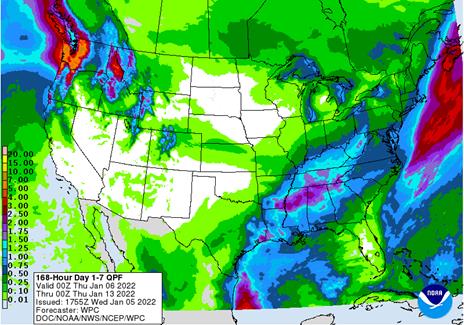
Week
two

Midday
– rain 17-19 Jan

World
Weather Inc.
WEATHER
EVENTS AND FEATURES TO WATCH
- Argentina’s
soil moisture is nearly depleted in a large part of the nation - The
latest soil assessment shows marginally adequate to slightly short subsoil moisture from southern Cordoba and northeastern La Pampa to central Buenos Aires where the best moisture has been present over the past couple of weeks - Argentina
was mostly dry Tuesday and early this morning and temperatures Tuesday afternoon were mostly in the upper 80s and lower 90s Fahrenheit except in southern Buenos Aires and southern La Pampa where 80s and a few upper 70s were noted. - In
contrast a few upper 90- and lower 100-degree highs continued in Formosa and neighboring areas of Chaco and northwestern Corrientes - Argentina
will receive very little rain of significance during the coming ten days - Any
showers that occur (and there will be some) will fail to counter evaporative moisture losses for the period resulting in a further depletion of soil moisture and a notably rising level of plant stress - Some
livestock stress is expected, as well which may impact milk production and reduce animal weight gains - Excessive
heat will be returning to Argentina this weekend and lasting through the middle part of next week with highs of 96 to 110 Fahrenheit common with a few extremes near and above 113 - Week
two weather in Argentina, Jan. 15-19, will offer some scattered showers and thunderstorms, but it is unclear today how significant that rain may or may not be - Temperatures
may also trend a little less hot during that period of time - Brazil
weather will include showers and thunderstorms to the entire nation’s crop areas at one time or another during the next week to ten days - The
lightest rain is expected in the far northeast - The
greatest rain is still predicted from Tocantins and some eastern Mato Grosso locations into Goias and Minas Gerais where the ground is already saturated and vulnerable to flooding if daily rainfall gets too great - Southwestern
Brazil (Mato Grosso do Sul and western Parana) rainfall may be greatest from late this weekend through next week at which time the greatest bolstering of moisture in the soil is expected - Brazil’s
week two outlook, Jan. 13-19, will bring less frequent and less significant rain to many areas, although complete dryness is unlikely - The
drier bias will be welcome for early soybean and corn maturation and harvesting, early Safrinha corn and cotton planting and for improving summer crop conditions in the wettest areas noted above - Temperatures
may also trend a little warmer as the rain subsides for a while, but no excessive heat is expected - Paraguay
is unlikely to get nearly as much rain as neighboring areas of Brazil may get and crop stress in the nation will remain serious – like that of Argentina - Rio
Grande do Sul is the one state in Brazil that will see ongoing declining crop and field conditions during the next ten days, although not all areas will be dry - Brazil
weather Tuesday and early today included scattered showers and thunderstorms in much of the nation along with mostly near to slightly below normal temperatures - Rainfall
was most beneficial in interior western and central Mato Grosso do Sul where 0.40 to 1.81 inches resulted
- One
unconfirmed rain amount of 4.20 inches was received from northwestern Mato Grosso do Sul - Northern
Parana received rain with 0.43 to 0.92 inch resulting and central Rio Grande do Sul reported 0.05 to 0.39 inch - Precipitation
elsewhere was concentrated on Sao Paulo, Goias, central and eastern Mato Grosso and western and southern Minas Gerais that was not heavy, but sufficient in maintaining wet field conditions - U.S.
weather was relatively tranquil Tuesday and overnight, but snow and blowing snow did impact the upper Midwest as the next surge of bitter cold air arrived on strong northerly winds - Some
rain and mountain snow continued in the Pacific Northwest with the next three days to bring some strong wind speeds and heavier precipitation
- Southwestern
British Columbia and the Puget Sound ports could be impacted by the adverse weather the next few days - Warming
Tuesday melted snow from the central U.S. Plains, but snow will fall later today and Thursday to help put back some protection to winter wheat against the coming bitter cold - Winterkill
is not likely to be significant if it occurs at all in hard red winter wheat areas due to some snow cover - Lowest
temperatures may slip into some negative teens Fahrenheit in Nebraska and northeastern Colorado while positive and negative single digits will occur in other areas southward through Kansas - Some
concern over possible winterkill also exists in the lower Midwest where low temperatures Friday morning will slip near or slightly below zero Fahrenheit from parts of Missouri to Indiana - Most
of the temperatures in this region will not be low enough for permanent crop damage, but the lack of snow cover in the region will leave crops at least vulnerable to damage if conditions get unexpectedly cold - A
weak nor’easter will bring light to locally moderate snow up the middle and northern U.S. Atlantic Coast Thursday into Friday result in 3 to 8 inches of accumulating snow - This
storm is much weaker than that advertised Tuesday and additional weakening may occur - U.S.
temperatures will turn warmer in the second week of the forecast after this first week is quite cool in the central and eastern states for a few days - West
and South Texas precipitation will be restricted over the next ten days to two weeks - Not
much rain will fall in California’s central valleys for a while and the heavy snow in the Sierra Nevada is over for a while - Heavy
rain, flooding and strong wind will impact the U.S. Pacific Northwest and British Columbia coasts the remainder of this week impacting shipping in the region - The
adverse conditions may be greatest later today into Friday - Some
flooding is possible - Not
much precipitation will impact U.S. hard red winter wheat areas during the next two weeks, although a few brief bouts of snow and a little rain might occur, but moisture content in the precipitation will not change drought status - Today
and early Thursday will be the best chance of moisture in the north with several inches of snow expected in the northwest - The
southwestern Plains will stay dry during much of the next ten days to two weeks maintaining drought status - U.S.
Delta and interior parts of the southeastern U.S. along with most of the central and eastern Midwest will remain plenty moist over the next two weeks - Drying
is needed near and south of the Ohio River into the Tennessee River Basin and northern Delta - Canada’s
Prairies will receive waves of snow during the next two weeks with southern and eastern areas getting the greatest amounts - East-central
and southern Alberta and west-central and southwestern Saskatchewan are still in a serious drought and the snowfall in those areas will be light and provide very little relief when it melts - Temperatures
will trend much warmer next week - Northern,
central and eastern India will receive waves of rain over the next ten days that will moisten the topsoil and help support crop development ahead of reproduction - Wheat,
millet, rapeseed and some pulse crops will be among the beneficiaries of the precipitation
- Southern
India will be relatively dry, although significant rain fell along the lower east coast during the weekend - Europe
weather has been and should continue to be good for dormant winter crops - Concern
about dryness in Spain may continue for a while, but soil moisture and snow cover should be sufficient for crops elsewhere over the next ten days - North
Africa precipitation will increase during mid- to late week this week in north-central and northeastern Algeria and northern Tunisia, but precipitation in Morocco will be quite limited - Southwestern
Morocco continues to be a notable multi-year drought and dryness is also a concern in northwestern Algeria - Crops
elsewhere are doing relatively well - Warmer
temperatures in parts of Ukraine and Russia’s Southern Region recently induced a little rain while snow fell frequently to the north - Snow
cover has been receding from eastern Europe, Ukraine and Russia’s Southern Region, but there is no threatening cold coming anytime soon - Cooling
next week and into the following weekend will reverse the trend putting back some of the snow lost - No
threatening cold weather is expected anytime soon in Europe or the western CIS - Snow
cover will remain widespread across much of Russia and the northernmost part of Ukraine as well as some areas in eastern Europe - Winter
crops are in good conditions no change is expected - China’s
weather will continue mostly uneventful for a while, although periods of rain and a little snow will impact the Yangtze River Basin during the next couple of weeks.
- The
moisture will preserve the integrity of the 2022 rapeseed and southern wheat crops - Snow
will fall periodically in the far northeast while the Yellow River Basin and southern coastal provinces receive little to no precipitation - Temperatures
will be near to slightly warmer than usual - Southeast
Asia oil palm, citrus, sugarcane, coffee, cocoa, rice and other crop areas of Indonesia, Malaysia and Philippines will receive frequent bouts of rain over the next two weeks - Some
heavy rain is possible, but no serious widespread flood problem is expected - Local
flooding will be possible, though - Mainland
areas of Southeast Asia will be mostly dry during the next ten days except Vietnam coastal areas where some moderate to heavy rain will be possible late this week and into the weekend - Australia
weather outlook has not changed much - Thunderstorms
are expected in central and eastern parts of New South Wales and a few interior southeastern Queensland locations during the second half of this week and into the weekend - Rainfall
will be greatest along the western slopes of the Great Dividing Range in New South Wales - The
precipitation may continue next week as scattered showers and thunderstorms that will benefit summer crops in both Queensland and New South Wales, although the rain in Queensland will be most restricted - Southeastern
Australia will be wettest including southeastern crop areas of New South Wales and central through eastern crop areas of Victoria - Temperatures
will be near to above normal - Late
season winter crop harvesting in the south should not be seriously impacted by rain since most of the crop has been harvested - South
Africa will experience a good mix of rain and sunshine during the next two weeks - The
long term summer outlook remains favorable - Western
summer crop areas have the greatest need for rain, and they should get at least some periodically - Temperatures
will be seasonable - West-central
Africa precipitation will be limited to coastal areas and temperatures will be a little warmer than usual - East-central
Africa will be erratic, but it is expected daily through the next ten days supporting coffee, cocoa, rice sugarcane and other crops - Middle
East precipitation is expected to be erratically distributed over the next couple of weeks
- Winter
crops will benefit from whatever rain falls, but it is not expected to be evenly distributed for a while - Mexico
weather will trend wetter in far southern and some extreme eastern crop areas during the coming week - Some
showers may evolve in north-central areas during the Jan. 13-19 period, but confidence is low - Central
America precipitation will be greatest along the Caribbean Coast , but including a fair amount of Panama and Costa Rica during the next ten days - A
few showers will occur in Guatemala periodically as well, although rainfall will be light - Western
Colombia and western Venezuela precipitation is expected to occur periodically in coffee, corn, rice and sugarcane production areas during the next ten days, but no excessive rain is expected - Today’s
Southern Oscillation Index was +11.33 and it was expected to drift lower for a while this week - New
Zealand rainfall is expected to continue getting less than usual precipitation this week with temperatures near to above normal
Source:
World Weather, inc.
Wednesday,
Jan. 5:
- EIA
weekly U.S. ethanol inventories, production - Malaysia’s
Jan. 1-5 palm oil exports - HOLIDAY:
Russia
Thursday,
Jan. 6:
- FAO
World Food Price Index - USDA
weekly net-export sales for corn, soybeans, wheat, cotton, pork and beef, 8:30am - Port
of Rouen data on French grain exports - HOLIDAY:
Russia
Friday,
Jan. 7:
- ICE
Futures Europe weekly commitments of traders report (6:30pm London) - CFTC
commitments of traders weekly report on positions for various U.S. futures and options, 3:30pm - HOLIDAY:
Russia
Source:
Bloomberg and FI
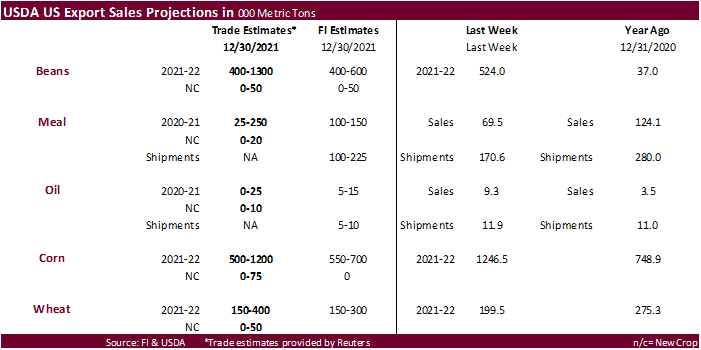
Macros
US
ADP Employment Change Dec: 807K (est 410K; prev 534K)
Canadian
Building Permits (M/M) Nov: 6.8% (est 1.8%; prev 1.3%; prevR 2.4%)
69
Counterparties Take $1.493 Tln At Fed Reverse Repo Op. (prev $1.496 Tln, 72 Bids)
US
DoE Crude Oil Inventories (W/W) 31-Dec: -2144K (est -3650K; prev -3576K)
–
Distillate Inventories: +4418K (est -1000K; prev -1726K)
–
Cushing OK Crude Inventories: +2577K (prev +1055K)
–
Gasoline Inventories: +10128K (est 1750K; prev -1459K)
–
Refinery Utilization: 0.10% (est 0.40%; prev 0.10%)
·
CBOT corn ended lower following weakness in wheat, build in US ethanol stocks, selloff in WTI crude oil and sharply lower close in US equity markets after the FED released hawkish minutes. Improvement to the week two weather outlook
for South America kicked off the selling, but a higher close in soybeans limited losses for corn. News has been thin this week and global export developments are stagnant. Its possible major importers are waiting for a break in prices so some business might
develop tonight into Thursday.
·
Technical selling should be noted today after prices traded sharply higher on Tuesday.
·
Funds were net sellers of an estimated net 6,000 corn contracts.
·
We still think March corn could trade up into the $6.25-$6.35 area if SA weather fails to improve. March settled today at $6.0950.
·
The USDA Broiler Report showed eggs set in the US down slightly from this time year ago and chicks placed down slightly. Cumulative placements from the week ending January 9, 2021 through January 1, 2022 for the United States
were 9.64 billion. Cumulative placements were up slightly from the same period a year earlier.
·
IHS Markit will issue its January US and world crop reports Thursday.
·
US weekly ethanol production declined 11,000 barrels per day to 1.048 million, more than expected (trade looking for 7,000 decline) and stocks increased a very large 683,000 barrels to 21.359 million, largest level since mid-August
2021. Blender net input of ethanol during the holiday was only 782,000 barrels, lowest since mid-February 2021 (pandemic levels). Imports were zero and implied in-transit ethanol were 339,000 barrels, in line with previous weeks.
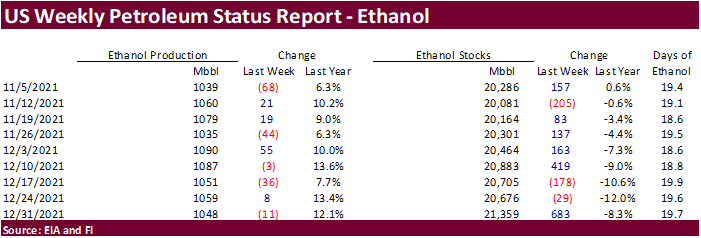
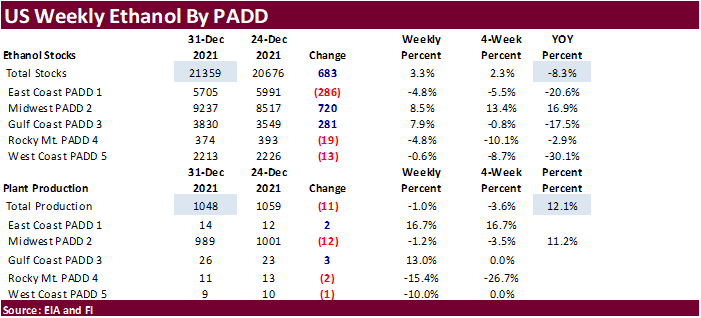
Export
developments.
·
None reported
Retail
gasoline prices rose across the United States in 2021 as driving increased
https://www.eia.gov/todayinenergy/detail.php?id=50758&src=email
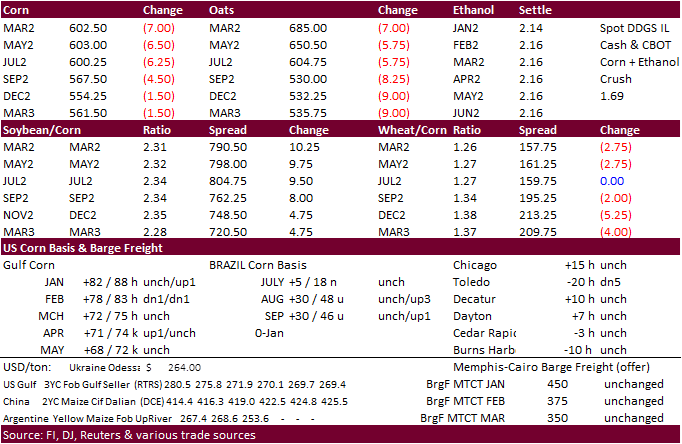
Updated
1/3/22
March
corn is seen in a $5.60 to $6.20 range
·
In a two-sided trade, CBOT soybeans settled 4.25-5.50 cents higher. Some SA weather maps indicated meaningful rain will occur across Argentina during the 17-20th January period. This week hot temperatures are still
expected to counter rain across Argentina. Soybean meal eased while soybean oil rallied following higher palm oil prices.
·
We see March soybeans now trading near $14.25 if the rains for southern portion of South America fail to shape up during the mid-January period. $14.5450 is the absolute contract high. We would not rule out $14.75 but next week
expect USDA to increase its 2021-22 US carryout amid a cut in US exports.
·
Today the funds bought 2,000 soybeans, sold 2,000 soybean oil and bought 3,000 soybeans.
·
Soybean basis at Burns Harbor, IN, was up 10 cents to 30 under the March.
·
March canola was up $1.60 to $1,023 per ton. One broker noted canola was overbought relative to other oilseeds.
·
We picked up earlier that AgRural lowered their Brazil bn crop to 133.4MMT, down 11.3 from previous with Parana taking a bit hit of 5.5MMMT.
·
Malaysian palm futures were up four consecutive sessions and hit a 6-week high overnight. Flooding is slowing production across the Peninsular Malaysia and Sabah.
·
ITS: Malaysia 1-5 Jan 2022 vs. 1-5 December 2021 palm oil exports – 125,205 vs. 255,500.
·
A Reuters poll looks for Malaysia’s palm oil inventories at end-December to sink 4.9% from the previous month to 1.73 million tons, lowest in five months.

Export
Developments
·
The CCC today seeks 12,000 tons of soybean oil for Feb 5-15 delivery for the Dominican Republic.
·
Under the 24-hour reporting system, USDA announced 132,000 tons of soybeans were sold to unknown for 2022-23 delivery.
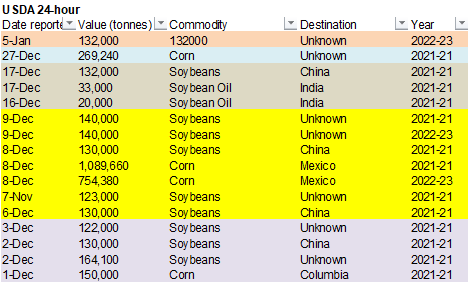
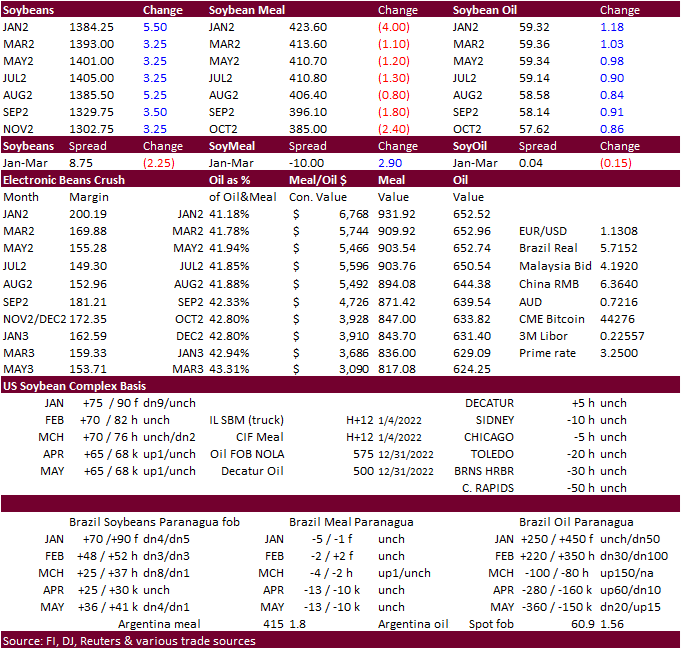
Updated
1/5/22
Soybeans
– March $13.00-$14.25 (unch, up 25 cents)
Soybean
meal – March $370-$435
Soybean
oil – March 53.00-61.00
(up 100 both sides)
·
US wheat traded lower on technical selling. A lower USD during much of the agriculture trade did little to slow the selling.
·
Funds sold an estimated net 5,000 SRW wheat contracts.
·
EU wheat basis the March position was 3.25 lower at 276 euros a ton.
·
China plans to sell 500,000 tons of wheat from state reserves on January 12 to flour millers. Results are awaited on China selling 500,000 tons of wheat from state reserves on January 5 to flour millers. The sold an estimated
891,938 tons of wheat from reserves in October.
·
Tunisia bought about 125,000 tons of soft wheat, 75,000 tons of durum wheat and 75,000 tons of animal feed barley. The soft wheat was bought in five 25,000 ton consignments, at $365.93, $365.93, $369.18, $367, and $369.95. Shipment
of the soft wheat was requested on various dates between Feb. 1 and March 25. The durum was bought at $693.68, $698.68 and $703.68, with shipment between Jan. 25 and Feb. 25. The barley was bought at $344.46, $345.46 and $346.46, with shipment due between
Feb. 1 and March 5.
·
Jordan’s state grain buyer bought 60,000 (out of 120,000 tons sought) of milling wheat, optional origin at an estimated $326 a ton c&f for shipment in the first half of August 2022.
·
Results awaited: Iraq seeks 50,000 tons of wheat on January 3 from the US, Canada and Australia.
Rice/Other
·
Bangladesh seeks 50,000 tons of rice on January 16.
·
Results awaited: Bangladesh
seeks 50,000 tons of non-basmati parboiled rice for delivery 50 days from contract award and letter of credit opening.
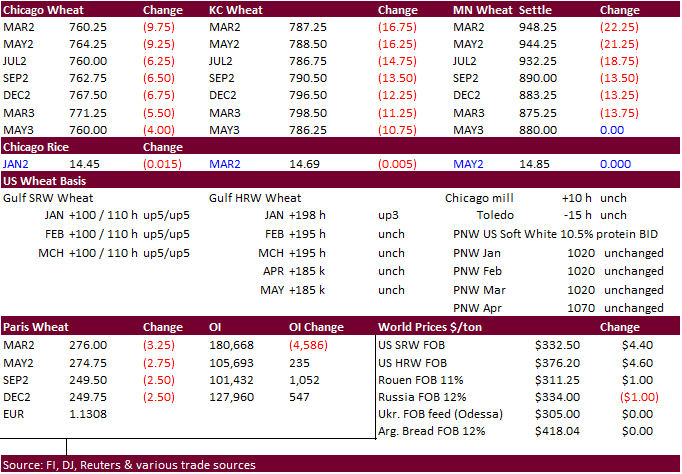
Updated
12/9/21
Chicago
March $7.40 to $8.60 range
KC
March $7.55 to $9.00 range
MN
March $9.50‐$11.00
Terry Reilly
Senior Commodity Analyst – Grain and Oilseeds
Futures International
One Lincoln Center
18 W 140 Butterfield Rd.
Oakbrook Terrace, Il. 60181
W: 312.604.1366
ICE IM:
treilly1
Skype: fi.treilly

Trading of futures, options, swaps and other derivatives is risky and is not suitable for all persons. All of these investment products are leveraged, and you can lose more than your initial deposit. Each investment product is offered
only to and from jurisdictions where solicitation and sale are lawful, and in accordance with applicable laws and regulations in such jurisdiction. The information provided here should not be relied upon as a substitute for independent research before making
your investment decisions. Futures International, LLC is merely providing this information for your general information and the information does not take into account any particular individual’s investment objectives, financial situation, or needs. All investors
should obtain advice based on their unique situation before making any investment decision. The contents of this communication and any attachments are for informational purposes only and under no circumstances should they be construed as an offer to buy or
sell, or a solicitation to buy or sell any future, option, swap or other derivative. The sources for the information and any opinions in this communication are believed to be reliable, but Futures International, LLC does not warrant or guarantee the accuracy
of such information or opinions. Futures International, LLC and its principals and employees may take positions different from any positions described in this communication. Past results are not necessarily indicative of future results.
